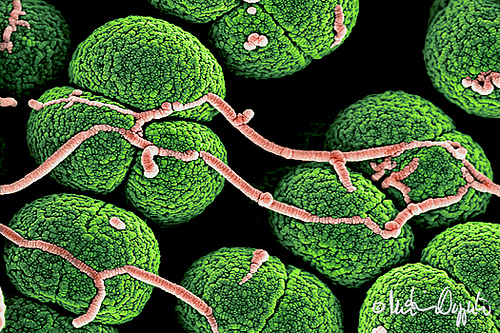
17 May EARTH MATTERS: IT’S THE LITTLE THINGS

Bacteria can cause human and animal diseases. However, some bacteria are not harmful at all and are responsible for the production of antibiotics. Still others live symbiotically in the gut of animals (including humans).
This week has been a time to start thinking small. From soil microorganisms, to edible bugs, to our own personal biota, small is big.
The New York Times has run two stories about little things in the last week. One, by the inimitable Michael Pollan, talks about how important microorganisms are to human health, and how our microbiomes, built of upwards of 100 trillion bacteria on any single person, are under threat from the Western “war on bacteria.” Indeed, far from avoiding dirt, eating processed foods, taking antibiotics with regularity, and using antibacterial wipes to clean every surface in our houses, we should be more open to more fiber, raw and fermented foods, and a bit of the right kind of dirt (but, scientists say, keep your toothbrush at least six feet away from your toilet, as flushing aerosolizes the contents of the bowl).
The right kind of dirt, however, poses another dilemma. Industrial agriculture and urbanization have been impoverishing our soil, as another New York Times story pointed out. Apart from the intrinsic problems of destroying of these poorly understood but incredibly diverse habitats, degrading healthy soil has the potential to harm human health in turn. Luckily, we are starting to get our hands dirty, with scientists starting to focus on the importance of soil biodiversity in providing ecosystem services.
Not only does healthy soil inhibit the spread of disease (for example, valley fever, which is spread through inhaling a fungus from dried-out soil), it holds potential cures for other diseases – it’s not just the Amazon that has organisms with antibiotic properties; it could be the ground beneath your feet. Healthy soils also produce healthier food, and need fewer (or no) inputs like fertilizer or pesticides to do so. Improving our agricultural practices – from the backyard, where we can use compost and avoid chemicals, to commercial agriculture, where avoiding tilling the soil and not using as many petrochemical inputs – could help sustain healthy soils, and in turn, sustain us.
The problems of industrial agriculture could also be solved in part by going small. We tend to think of animal protein as beef, pork, chicken, or fish. Eating any of these (especially beef) can create or exacerbate environmental problems, especially when the animals are raised in industrial, mass-production environments, where the impact is greater. Cattle produce 20% of U.S. methane emissions and Concentrated Animal Feeding Operations (CAFOs) can create serious pollution not to mention the issue of humane treatment of animals. Additionally, mass concentration of animals can create an environment in which it is easier for disease to spread, and industrial animal production often relies on inputs like antibiotics to avoid disease and increase growth, despite growing problems of antibiotic resistance (exacerbated also by the abovementioned “war on bacteria”).
So how could going small help? By eating bugs. A recent UN Food and Agriculture Organization report noted how efficient bugs are in feed conversion rates – 12 times more efficient than cattle – and how nutritious insects are. You can get an overview of the report in the BBC and I will write more on eating insects in an upcoming blog.


Sorry, the comment form is closed at this time.